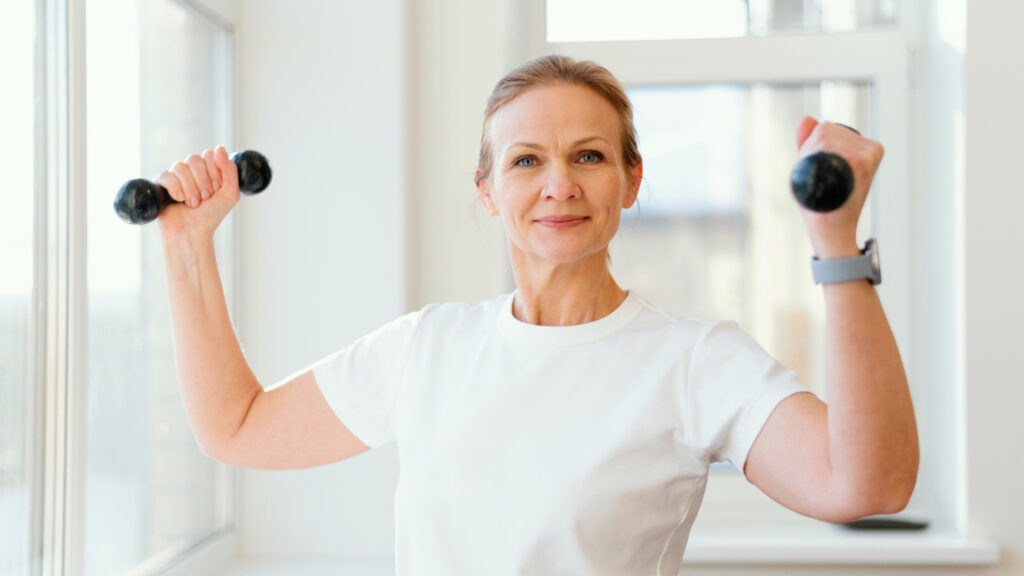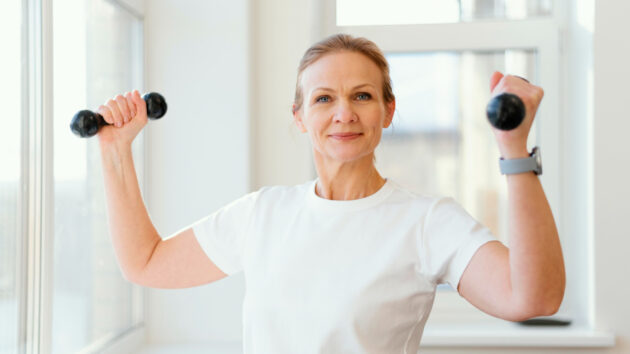
Menopause, a natural phase in every woman’s life that occurs in her late 40s or early 50s, marks the end of her reproductive years. This transitional period brings about various hormonal changes within her body, leading to symptoms like mood swings, hot flashes, and fatigue, all of which can affect her daily life.
While experiencing these changes, maintaining a healthy lifestyle becomes more important than ever, with exercise playing a significant role in promoting physical and mental well-being. These five tricks and tips will help you hit the gym during menopause and seek the relief you deserve.
Table of Contents
What Is Menopause?
Menopause is a biological event characterized by the cessation of menstrual periods for 12 consecutive months. This gradual process involves hormonal fluctuations, particularly a decline in estrogen levels, leading to symptoms like irregular periods, night sweats, and vaginal dryness.
The stages of menopause include perimenopause, menopause itself, and postmenopause, each phase encompassing unique challenges and adjustments for women. Menopause can cause changes in motivation, energy levels, and body composition, making it more challenging to engage in physical activity.
However, regular exercise during this time offers numerous benefits, such as improving bone density, managing weight, reducing the risk of heart disease, and enhancing mood and mental clarity. Exercise can also help manage menopausal symptoms like hot flashes and insomnia, making it a vital component of a woman’s wellness routine during this period.
Trick #1: Find the Right Menopause Supplements
During menopause, some women may consider incorporating menopause supplements into their regimen to support their overall health and well-being. Menopause supplements often contain vitamins, minerals, and herbal extracts that can help manage symptoms like fatigue, mood swings, and joint discomfort.
Before choosing a supplement, it’s vital to consult with a healthcare provider to determine which options are safe and suitable for your individual needs. Look for supplements specifically formulated for menopause support, like MENO menopause supplements, for hormone-free, science-backed relief.
Trick #2: Embrace Low-Impact Workouts
Low-impact workouts are ideal for women going through menopause, as they’re gentle on the joints and can help improve cardiovascular health without placing excessive strain on your body. Activities like walking, swimming, cycling, and yoga are excellent choices that can enhance your flexibility, balance, and muscle tone.
These exercises promote physical fitness while reducing stress levels, which is beneficial for managing menopausal symptoms like anxiety and irritability. Prioritizing low-impact workouts allows women to stay active and maintain their fitness levels while reducing the risk of injury.
Trick #3: Create a Supportive Routine
Establishing a supportive workout routine is essential to maintaining consistency and motivation during menopause. Incorporating exercise into your daily schedule can make it a priority and ensure you stay committed to your fitness goals. For example, be sure to identify the best time of day for your workouts, whether that’s in the morning or the evening after work.
Setting aside dedicated time for physical activity, even for short intervals, can significantly improve how easily you integrate exercise into your routine. Additionally, involving a friend or family member in your workouts can provide accountability and support, making exercise more enjoyable and sustainable.
Trick #4: Set Realistic Goals
Setting realistic and achievable goals is crucial for long-term success when it comes to fitness during menopause. Instead of aiming for drastic changes or extreme transformations, focus on gradual progress and improvements in strength, endurance, or flexibility.
Celebrate small victories along the way, such as completing a workout session or trying a new exercise. By setting achievable goals and acknowledging your accomplishments, you can stay motivated and build confidence in your ability to maintain a consistent fitness routine.
Trick #5: Prioritize Rest and Recovery
Rest and recovery are equally important components of a balanced fitness regimen, especially during menopause, when your body may require more time to recover from intense workouts. Incorporating rest days into your schedule allows your muscles to repair and rebuild, reducing the risk of injury and fatigue.
Listen to your body’s cues and prioritize sleep to promote hormonal balance and overall well-being. Relaxation techniques like gentle stretching or yoga can also help alleviate stress and enhance recovery, ensuring you feel refreshed and energized for your next session.
Your Guide To Making Gym Time Easier
Moving through menopause can be challenging, but integrating exercise into your routine can improve your quality of life. By implementing these strategies, you can make hitting the gym easier and more enjoyable.
Remember that staying active and maintaining a positive attitude towards fitness can have a transformative impact on your physical and mental health. Embrace the journey, listen to your body, and celebrate every step towards a fitter lifestyle.
